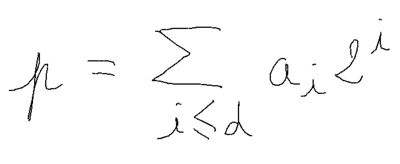CROHME: Competition on Recognition of Online Handwritten Mathematical Expressions
Datasets -> Datasets List -> Current Page
|
Contents
Contact Author
Harold Mouchère L’UNAM/IRCCyN/Université de Nantes, rue Christian Pauc, 44306 Nantes, France e: harold.mouchere@univ-nantes.fr
License
This work is licensed under a Attribution-NonCommercial-ShareAlike 3.0 Unported (CC BY-NC-SA 3.0) License
Current Version
2.0
Keywords
Online Handwritting, Mathematical Expression Recognition, layout analysis, character recognition, Math retrieval
Description
The dataset provides 2170 expressions handwritten by 347 writers from 3 different countries (France, India, Korea). Writers were asked to copy printed expressions from a corpus of 415 different expressions. The corpus has been designed to cover the diversity proposed by the different tasks and chosen from existing Math corpora and from expressions embedded in wikipedia pages. Different devices have been used (different digital pen technologies, white-board input device, tablet with sensible screen) so different scales and resolutions are used. The dataset provides only the on-line signal.
Furthermore, 6 participants of the last competition provided their recognized expressions for the test part. This data allows research on decision fusion or evaluation metrics.
The dataset is part of the "Competition on Recognition of Online Handwritten Mathematical Expressions" organised in the context of ICFHR 2012.
Metadata and Ground Truth Data
The ink corresponding to each expression is stored in an InkML file. The ground-truth information is included in the used InkML/MathML format. An InkML file mainly contains three kinds of information:
- the ink: a set of traces made of points
- the symbol level ground truth: the segmentation and label information of each symbol of the expression
- the expression level ground truth: the MathML structure of the expression
The two levels of ground truth information (at the symbol as well as at the expression level) are entered manually. Furthermore, some general information is added in the file:
- the channels (here, X and Y)
- the writer's information (identification, handedness (left/right), age, gender, etc.), if available
- the LaTeX ground truth (without any reference to the ink and hence easy to render)
- the unique identification code of the ink (UI), etc.
The InkML format makes references between the digital ink of the expression, its segmentation into symbols and its MathML representation. Thus, the stroke segmentation of a symbol can be linked to its MathML representation.
The recognized expressions are the outputs of the recognition competitors' systems. The same InkML format is used, but without the ink information (only segmentation, label and MathML structure).
Related Tasks
Math Expression Recognition
Purpose: the difficulty to recognize math expressions depends on the number of different symbols, the number of allowed layouts and the used grammar. The CROHME competition defines 3 levels (tasks) from 41 symbols to 75 symbols, with increasing difficulty in the grammar of allowed expressions.
Evaluation Protocol: The competition defines the following evaluation protocol:
- Participants can use any available training dataset, including the one provided
- The candidate systems take as input an inkml file (without ground-truth) and have to write as output a inkml file with the symbol segmentation, recognition and the expression interpretation with MathML format. This is exactly the same format as the provided in the training dataset.
- During the evaluation the resulting inkml file is compared to the ground-truth using a provided script.
Five aspects are measured and exported in the results report. They are:
- ST_Rec: the stroke classification rate, representing the percentage of strokes with the correct symbol
- SYM_Seg: the symbol segmentation rate, defining the percentage of symbols correctly segmented
- SYM_Rec: the symbol recognition rate, computing the performance of the symbol classifier when considering only the correct segmented symbols
- STRUCT: the MathML structure recognition rate, computing the percentage of expressions (MEs) having the correct MathML tree as output irrespective of the symbols attached to its leaves
- EXP_Rec: the expression recognition rate, which informs the percentage of MEs totally correctly recognized
- EXP-Rec_1, _2, _3: giving the percentage of MEs recognized with with at most 1 error, 2 errors and 3 errors (in terminal symbols or in MathML node tags) given that the tree structure is correct
As the MathML structure is not unique for the same expressions, the evaluation tool provides a normalization step to use canonical structures. The evaluation tool is provided (see the Downloads section). The evaluation script uses the Perl language which is available for most operating systems.
A grammar parser is also available. It allows to check if a latex expression is include in one of the three defined tasks. The grammar validator uses Java.
References
- Mouchère H., Viard-Gaudin C., Garain U., Kim D. H., Kim J. H., "CROHME2011: Competition on Recognition of Online Handwritten Mathematical Expressions", Proceedings of the 11th International Conference on Document Analysis and Recognition, ICDAR 2011, China (2011) (PDF)
- Mouchère H., Viard-Gaudin C., Garain U., Kim D. H., Kim J. H., "ICFHR 2012 - Competition on Recognition of Online Mathematical Expressions (CROHME2012)", Proceedings of the International Conference on Frontiers in Handwriting Recognition, ICFHR 2012, Italy (2012) (PDF)
Download
Version 1.0
- The complete CROHME dataset including the evaluation tools (28 MB)
- CROHME sample files including examples of different inkml files and evaluation results produced with the included software (20 KB)
This page is editable only by TC11 Officers .
